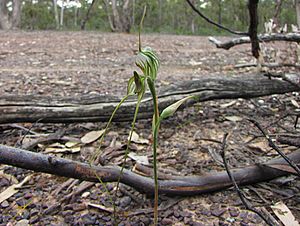Long-tailed rustyhood facts for kids
Quick facts for kids Long-tailed rustyhood |
|
|---|---|
 |
|
| Pterostylis woollsii growing near Whroo in Victoria | |
| Scientific classification | |
| Genus: |
Pterostylis
|
| Species: |
woollsii
|
| Synonyms | |
|
Oligochaetochilus woollsii (Fitzg.) Szlach. |
|
The long-tailed rustyhood (scientific name: Pterostylis woollsii) is a special kind of orchid plant. It grows only in eastern Australia. This orchid gets its name from its unique flowers. They have very long, thin tips that look a bit like tails. It also has a reddish-brown part that looks like an insect!
Contents
What the Long-tailed Rustyhood Looks Like
The long-tailed rustyhood is a perennial plant. This means it lives for more than two years. It is also a deciduous herb, so its leaves fall off each year. This plant grows from an underground tuber, which is like a small storage organ.
Leaves and Stems
At the bottom of the flowering stem, it has a group of leaves called a rosette. There are usually six to ten leaves in this rosette. Each leaf is shaped like a spear or an egg. They are about 15 to 35 millimeters (about 0.6 to 1.4 inches) long. They are also about 8 to 14 millimeters (about 0.3 to 0.6 inches) wide. Often, these leaves have dried up by the time the flowers appear.
The main stem, where the flowers grow, can be quite tall. It reaches between 200 and 450 millimeters (about 8 to 18 inches) high. Along this stem, there are two to five smaller leaves wrapped around it.
Flowers and Their Unique Features
This orchid can have up to six flowers on its stem. These flowers are partly clear, with hints of green and reddish colors. Each flower is quite large, about 35 to 60 millimeters (about 1.4 to 2.4 inches) long. They are also about 12 to 14 millimeters (about 0.5 inches) wide. Each flower hangs on the end of a long, thin stalk.
- The Hood (Galea): The top part of the flower forms a hood. This hood is called the "galea." It is made from the top sepal (a leaf-like part) and the petals joining together. This galea covers the central part of the flower. The top sepal has a thin, thread-like tip. This tip is about 15 to 20 millimeters (about 0.6 to 0.8 inches) long and often bends upwards.
- The Long Tails: The side sepals of the flower point downwards. They are wider than the galea. Their outer edges are covered in tiny hairs. These sepals suddenly narrow into very long, thread-like tips. These "tails" are super long, measuring about 90 to 130 millimeters (about 3.5 to 5.1 inches)!
- The Insect-like Lip (Labellum): The most interesting part is the "labellum." This is a special lip-like petal. It is dark reddish-brown, thin, and looks a lot like an insect. It's about 10 to 11 millimeters (about 0.4 inches) long and 3 to 4 millimeters (about 0.1 to 0.2 inches) wide. This labellum is also hairy.
The long-tailed rustyhood usually flowers between October and December.
How it Got its Name
The Pterostylis woollsii was first officially described in 1876. A botanist named Robert D. FitzGerald wrote about it in his book, Australian Orchids.
Fitzgerald named the species "woollsii" to honor his friend, Dr. Woolls. Dr. Woolls was a very important person in learning about the plants of New South Wales. He even sent Fitzgerald some samples of this orchid that he found near Richmond.
Where the Long-tailed Rustyhood Lives
The long-tailed rustyhood grows in different parts of eastern Australia. It has a "disjunct distribution." This means it's found in separate areas, not all in one continuous patch.
- In New South Wales, it grows in forests. You can find it in grassy or rocky places.
- It also grows in Queensland, as far north as Carnarvon Gorge.
- However, in Victoria, it is only known from the Rushworth area.
Conservation Status
Sadly, the Pterostylis woollsii is considered "endangered" in Victoria. This means there are very few of these plants left, and they are at high risk of disappearing forever. The Victorian Government protects it under a law called the Flora and Fauna Guarantee Act 1988.

